Candlestick patterns bullish, bearish, and neutral are the most important and popular in the technical analysis of the stock market or share market. It gives an idea about the stock market price direction i.e. uptrend (bullish) or downtrend (bearish) of the stock market price.
Candlestick chart or patterns helps to make the right decisions for buying and selling stocks or shares. Traders and Investors can create wealth from the stock market or securities market by mastering the candlestick patterns, technical analysis tools, and proper risk management approach.
Table of Contents
CANDLESTICK BAR | CANDLESTICK COMPONENTS
A candlestick bar is a way of displaying information about a market price movement.
A candlestick bar has five components – open, close, high, and low prices for a specific period, and a body that shows the open-to-close price range. Let’s examine a picture of a daily candlestick bar:
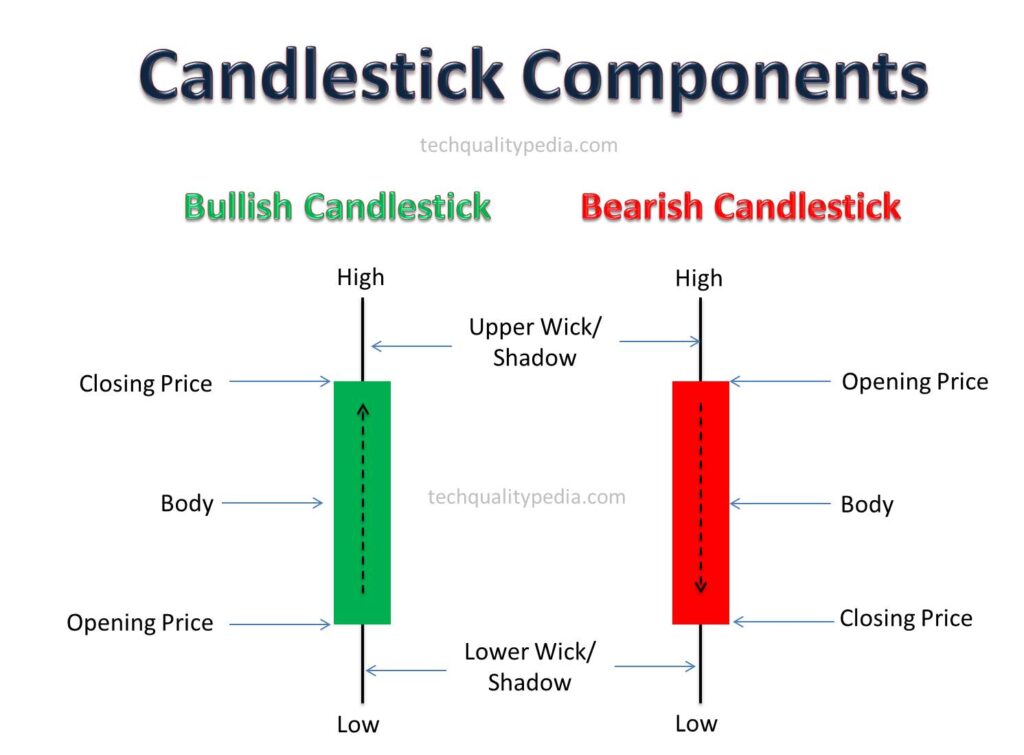
- Open Price: this is the first price at which the stock trades in one specific period.
- Close Price: this is the last price at which the stock trades in one specific period.
- High price: this is the highest price of the stock reached during the specific period.
- Low price: this is the lowest price of the stock reached during the specific period.
- Body: shows the open-to-close price range. The body color represents the direction of market movement i.e. indicates bullish or bearish price movement. A green body shows a price increase, while a red body shows a price decrease. A Green body is formed when the opening price is lower than the closing price, and a Red body is formed when the opening price is greater than the closing price.
CANDLESTICK PATTERNS | TYPES
Candlestick chart patterns are categorized into three ways:
- Bullish Patterns: Such as the Hammer, Dragonfly Doji, Bullish Engulfing, Morning Star, and Bullish Spinning Top.
- Bearish Patterns: Such as the Hanging Man, Shooting Star, Bearish Engulfing, Gravestone Doji, and Evening Star.
- Neutral Patterns: Such as the Doji, which can indicate indecision (can be bullish or bearish).
The most commonly used candlestick patterns categorized into bullish, bearish, and neutral patterns are briefly explained below with the image:
CANDLESTICK PATTERNS BULLISH
Bullish patterns may usually form after a market downtrend and indicate a probability of a bullish reversal trend i.e. upward price movement. Bullish candlestick patterns suggest that buyers are in control and move market prices upward direction.
The candlestick patterns bullish include:
Single Candlestick Pattern
- Hammer
- Inverted Hammer
- Dragonfly Doji
- Bullish Marubozu
Double Candlestick Pattern
- Bullish Engulfing
- Bullish Harami
Tripple Candlestick Pattern
- Morning Star
Candlestick Patterns Hammer
There are two types of Hammers patterns formed:
- Hammer Candlestick Pattern
- Inverted Hammer Candlestick Pattern
Hammer Candlestick Patterns
Image Description: A single candlestick with a small body at the top having a long lower wick(shadow) at least twice the body size and no or very small upper wick(shadow). The body color of a hammer candlestick can be either green or red.
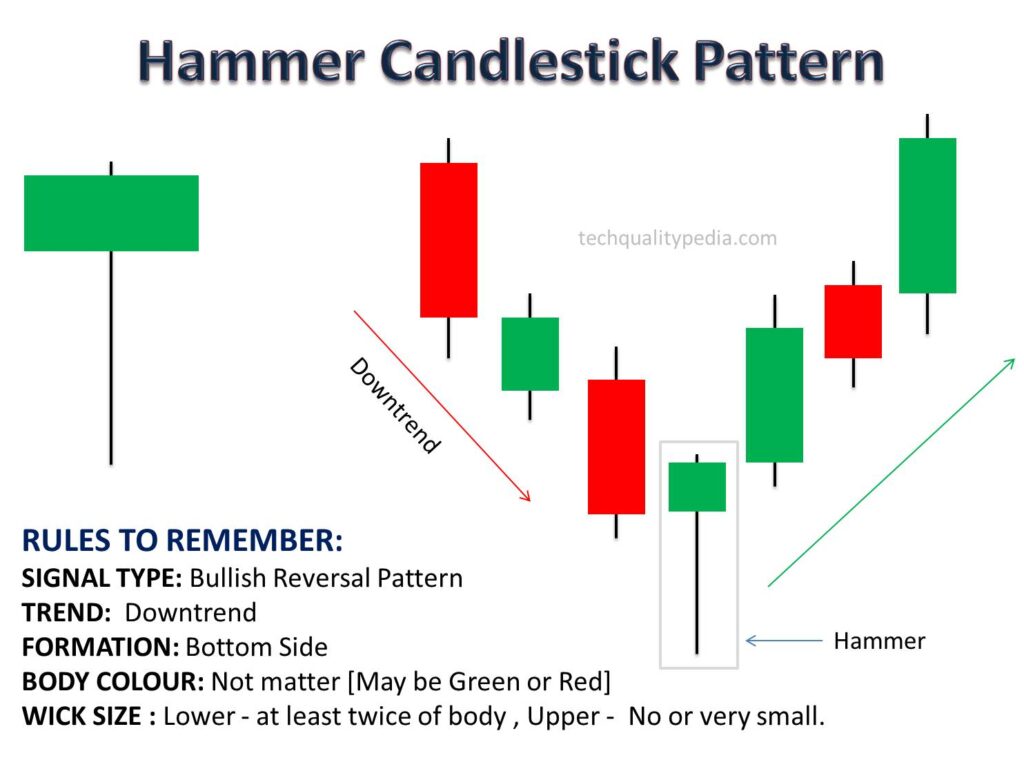 Explanation: The Hammer pattern appears after a downtrend and formed at the bottom side, indicating a bullish reversal pattern. The long lower wick suggests that sellers pushed prices downward but buyers managed to drive them upward, showing more buyer’s control/strength.
Explanation: The Hammer pattern appears after a downtrend and formed at the bottom side, indicating a bullish reversal pattern. The long lower wick suggests that sellers pushed prices downward but buyers managed to drive them upward, showing more buyer’s control/strength.
Inverted Hammer Candlestick Patterns
Image Description: A single candlestick with a small body at the bottom having a long Upper wick(shadow) at least twice the body size and no or very small Lower wick(shadow). The body color of a hammer candlestick can be either green or red.
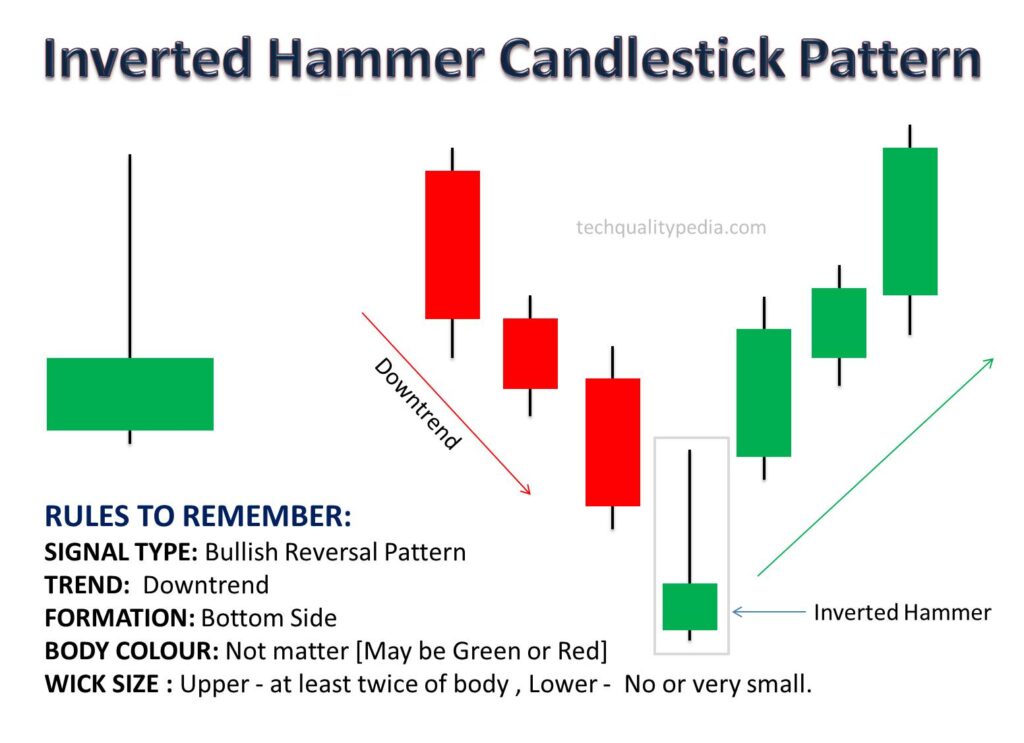 Explanation: The Inverted Hammer pattern appears after a downtrend and indicates a bullish reversal pattern. The long upper wick indicates that buyers are in control and push the price upward during the session, but sellers managed to move the price downward near the opening level. However, a long upper wick suggests buyers may take control soon and lead to bullish momentum.
Explanation: The Inverted Hammer pattern appears after a downtrend and indicates a bullish reversal pattern. The long upper wick indicates that buyers are in control and push the price upward during the session, but sellers managed to move the price downward near the opening level. However, a long upper wick suggests buyers may take control soon and lead to bullish momentum.
Dragonfly Doji Candlestick Patterns
Image Description: The Dragonfly Doji candle patterns have very small or no upper wick and a long lower wick. The open, close, and high prices are nearly the same or very close and appear at the top of the candle.
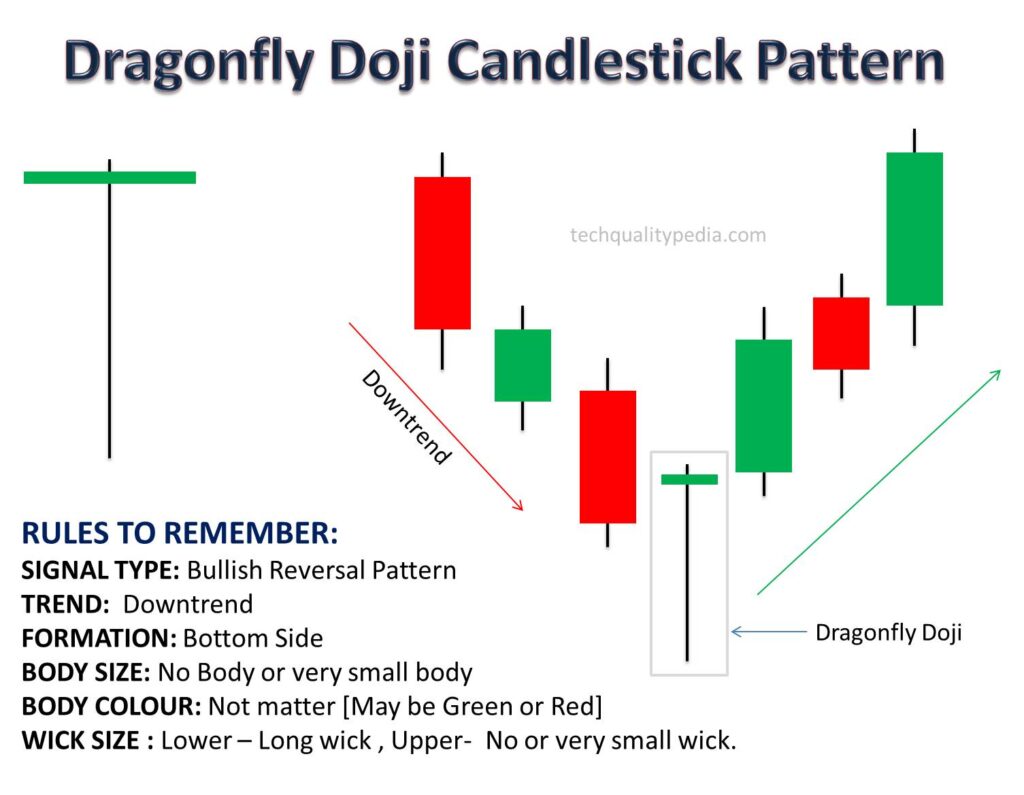
Explanation: The Dragonfly Doji appears after a downtrend and signals a bullish reversal. Initially, sellers pushed the price downward, but buyers managed to push back the price near the opening price level. This shows that the sellers were strong initially but at the end of the session, buyers became stronger and lifted the price.
Candlestick Patterns Marubozu
The Marubozu is a Japanese term that means “bald head” or “shaved head”. A Marubozu pattern is formed with a long body with no wick or shadows. It can either be a green candlestick body (Bullish) or a red candlestick body (Bearish)
There are two types of Marubozu candlestick patterns formed:
- Bullish Marubozu Candlestick Pattern
- Bearish Marubozu Candlestick Pattern
Bullish Marubozu Candlestick Patterns
Image Description: A Bullish Marubozu Candlestick pattern is formed with a long green body and no upper or lower wicks.
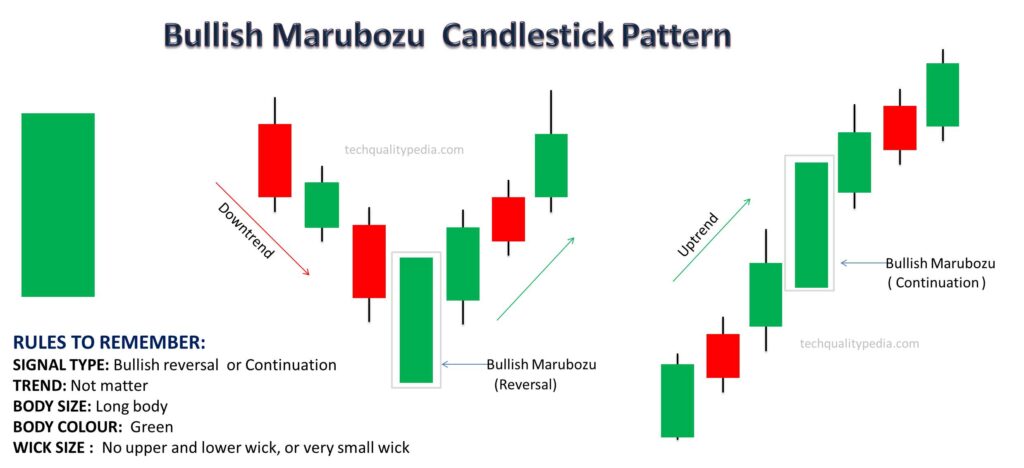 Explanation: A Bullish Marubozu indicates strong buying pressure from start to finish. The buyers were in control and managed to move the price upward during the entire session without any resistance from sellers.
Explanation: A Bullish Marubozu indicates strong buying pressure from start to finish. The buyers were in control and managed to move the price upward during the entire session without any resistance from sellers.
Bullish Reversal or Continuation: It usually appears after a downtrend and signals the start of a bullish reversal. If it appears during an uptrend, it may signal the continuation of the bullish momentum.
Candlestick Patterns Engulfing
There are two types of Engulfing Candlestick formed:
- Bullish Engulfing Candlestick
- Bearish Engulfing Candlestick
Bullish Engulfing Candlestick
Image Description: The image is formed with Two candlesticks. The first is a small red candle, and the second is a larger green candle that fully engulfs the red candle.
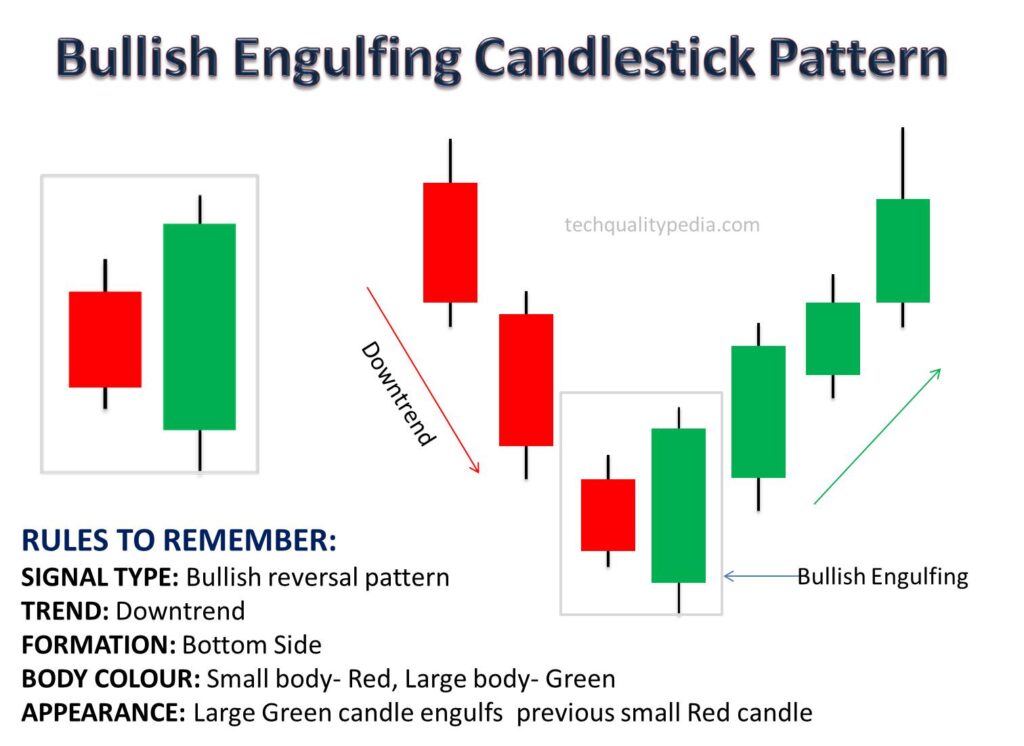
Explanation: This pattern forms when a larger bullish candle (green candlestick) engulfs or covers a previous small bearish candle (red candlestick) entirely. Indicating strong buyer’s control and a bullish reversal trend.
Bullish Harami Candlestick Patterns
Image Description: The Bullish Harami form with two candles. The first is a long red-body candle, and the second is a smaller green-body candle, which is entirely contained within the long red-body candle.
Explanation: The Bullish Harami candlestick appears after a downtrend and indicates a bullish reversal. The large red body candle shows strong selling pressure, but the smaller green candle inside the long red candle indicates that sellers are losing control, and buyers are gaining strength which could lead to a price upward.
Candlestick Patterns Morning Star
Image Description: Morning star candlestick patterns form with three candlesticks. The first one is a long candle with a red color body, followed by a small candle (it can be a green or red color body), and the third one is a long candle with a green body.
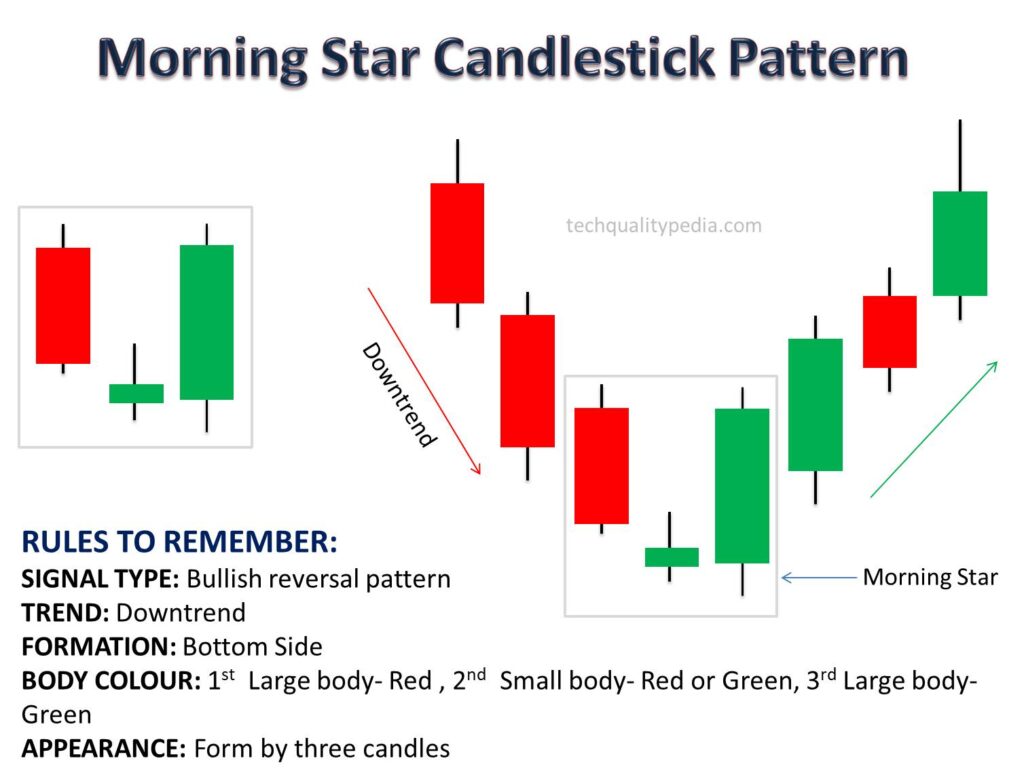
Explanation: Candlestick patterns morning star form a bullish reversal pattern after a downtrend. The small middle candle indicates indecision, and the third candle confirms the strong bullish reversal.
CANDLESTICK PATTERNS BEARISH
Bearish patterns may always form after an uptrend and indicate a probability of a bearish reversal trend i.e. downward price movement. It suggests that sellers are in control, and move market prices downward direction.
The Candlestick Patterns Bearish include:
Single Candlestick Pattern
- Shooting Star
- Hanging Man
- Gravestone Doji
- Bearish Marubozu
Double Candlestick Pattern
- Bearish Engulfing
- Bearish Harami
Tripple Candlestick Pattern
- Evening Star
Candlestick Patterns Shooting Star
Image Description: A single candlestick with a small body at the bottom. The long upper wick is at least twice the body size, and very small or no wick at the bottom. It is similar to an Inverted hammer but appears after an uptrend.
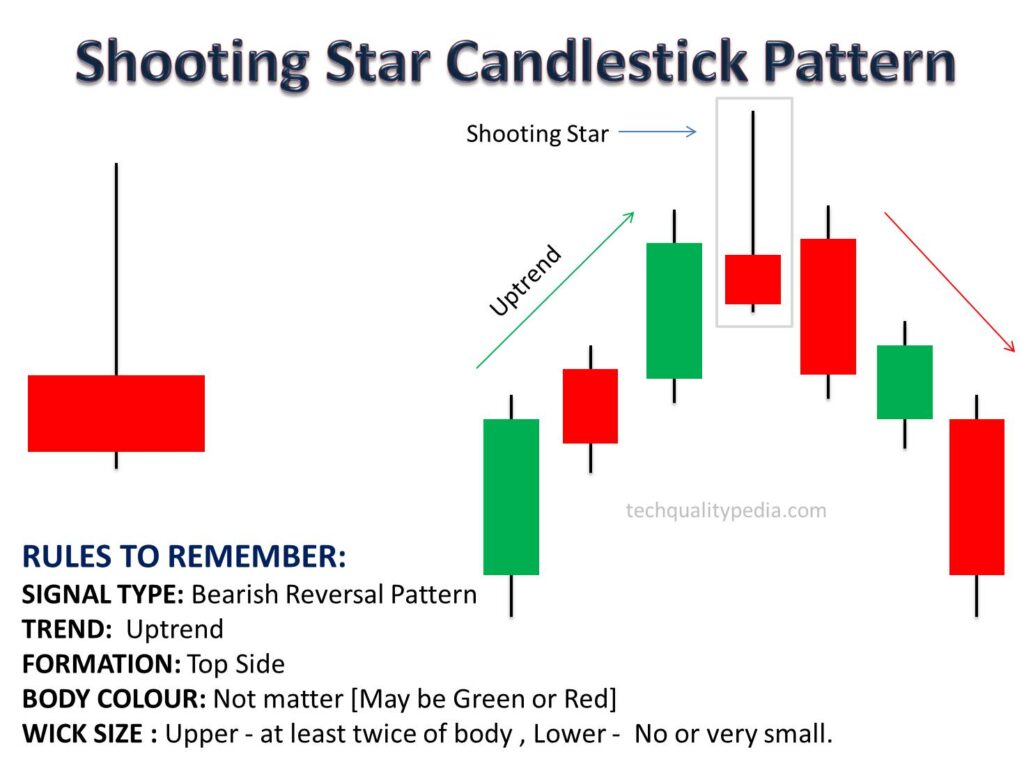
Explanation: It forms after an uptrend. The long upper wick shows buyers pushed prices upward, but sellers managed to move prices downward, indicating sellers are in control and a probability of bearish trend reversal.
Candlestick Patterns Hanging Man
Image Description: A Hanging Man candlestick is formed with a small body near the upper part of the candlestick. There is a very small or no upper shadow or wick and a long lower wick (at least twice the body size).
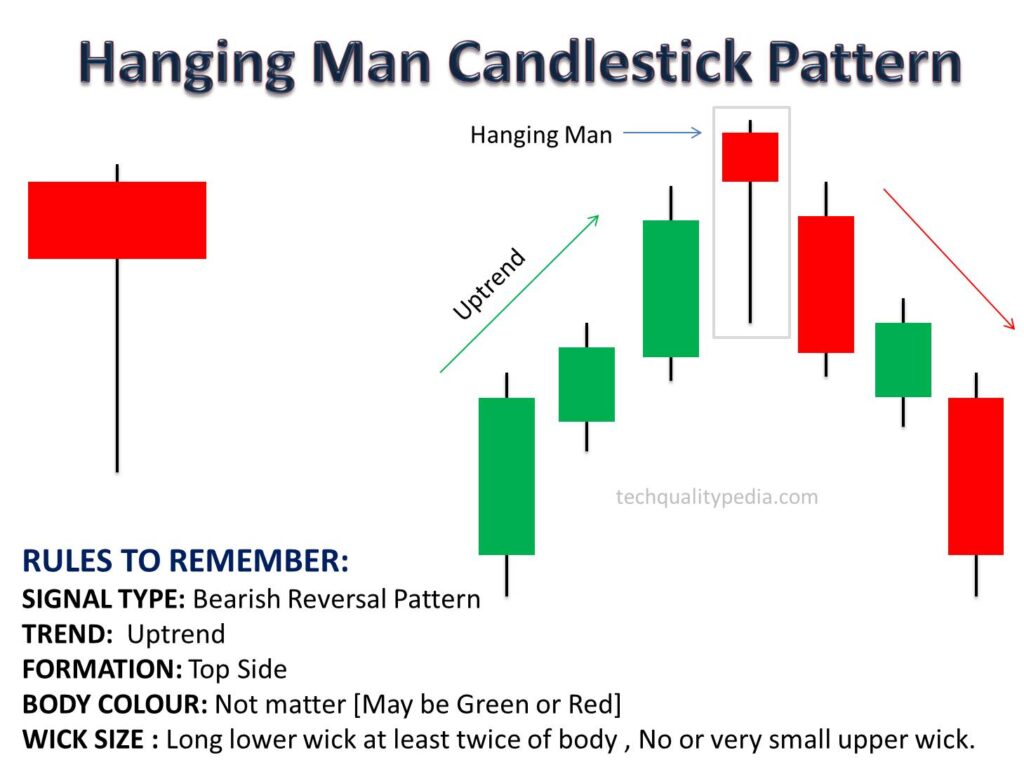
Explanation: The Hanging Man candle appears after an uptrend and indicates a bearish reversal pattern. It suggests that sellers were strong during the session, but buyers managed to move the price back near the opening price. However, a long lower shadow indicates sellers may take control soon and push the price downward.
Candlestick Patterns Gravestone Doji
Image Description: The Gravestone Doji candle patterns have very small or no lower wick and a long upper wick. The open, close, and low prices are nearly the same or very close and appear at the bottom of the candle.
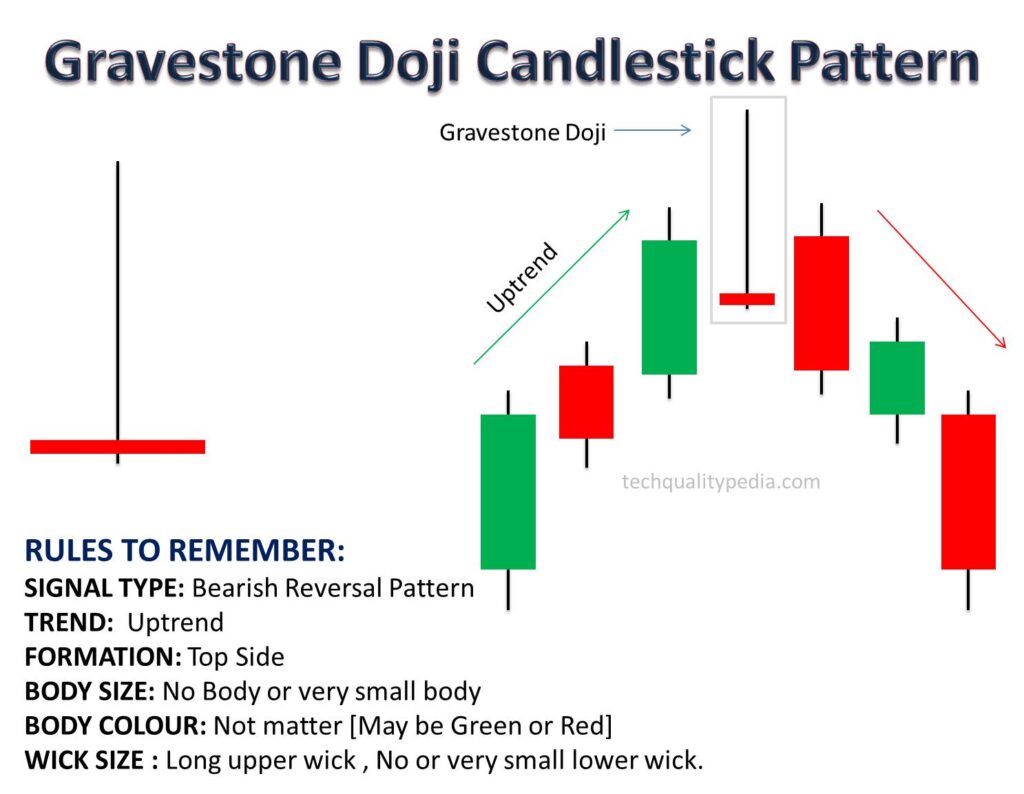
Explanation: The Gravestone Doji appears after an uptrend and signals a bearish reversal. Initially, buyers push the prices upward, but sellers regain control and move the price downward near the opening level.
Candlestick Patterns Bearish Marubozu
Image Description: A Bearish Marubozu Candlestick pattern is formed with a long red body and no upper or lower wicks.
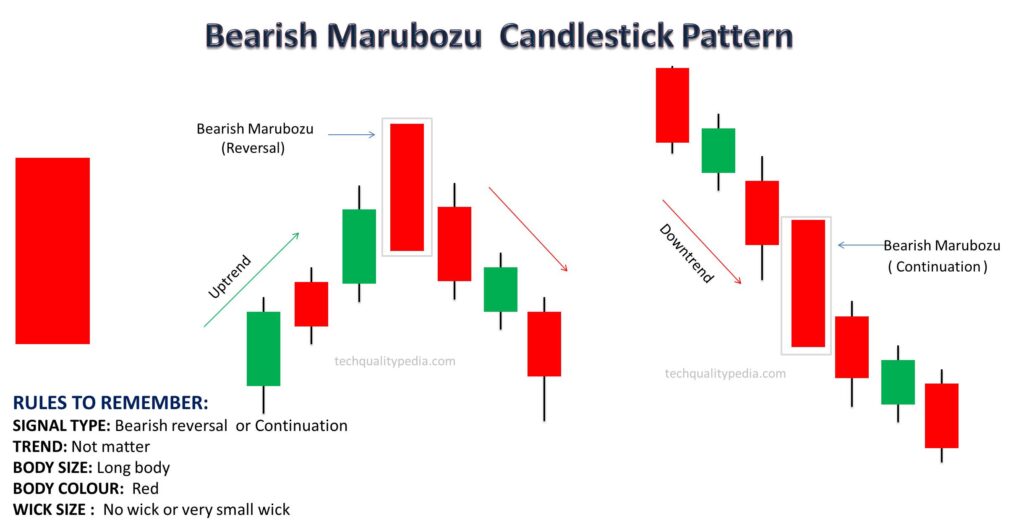
Explanation: A Bearish Marubozu indicates strong selling pressure from start to finish. The sellers were in control and managed to move the price downward during the entire session without any resistance from the buyers.
Bearish Reversal or Continuation: It usually appears after an uptrend and signals the start of a bearish reversal. If it appears during a downtrend, it may signal the continuation of the bearish momentum.
Bearish Engulfing Candlestick
Image Description: Bearish engulfing candlestick pattern form with two candlesticks. The first one is a small candle with a green body, and the second one is a larger candle with a red body that fully engulfs the previous small green candle.
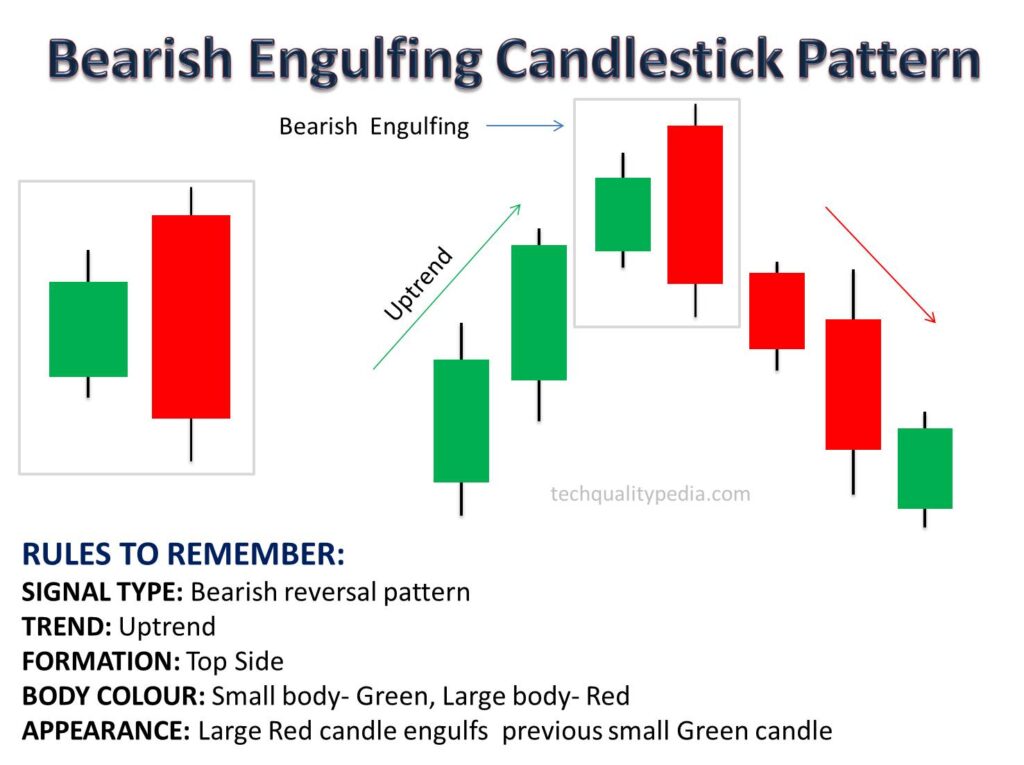
Explanation: This pattern forms when a larger bearish candle (red candlestick) engulfs or covers a previous smaller bearish candle (green candlestick) entirely. Indicating sellers are in control and a bearish reversal trend.
Bearish Harami Candlestick
Image Description: The Bearish Harami also form with two candles. The first is a long green body candle, and the second is a smaller red body candle, which is entirely contained within a long green body candle.
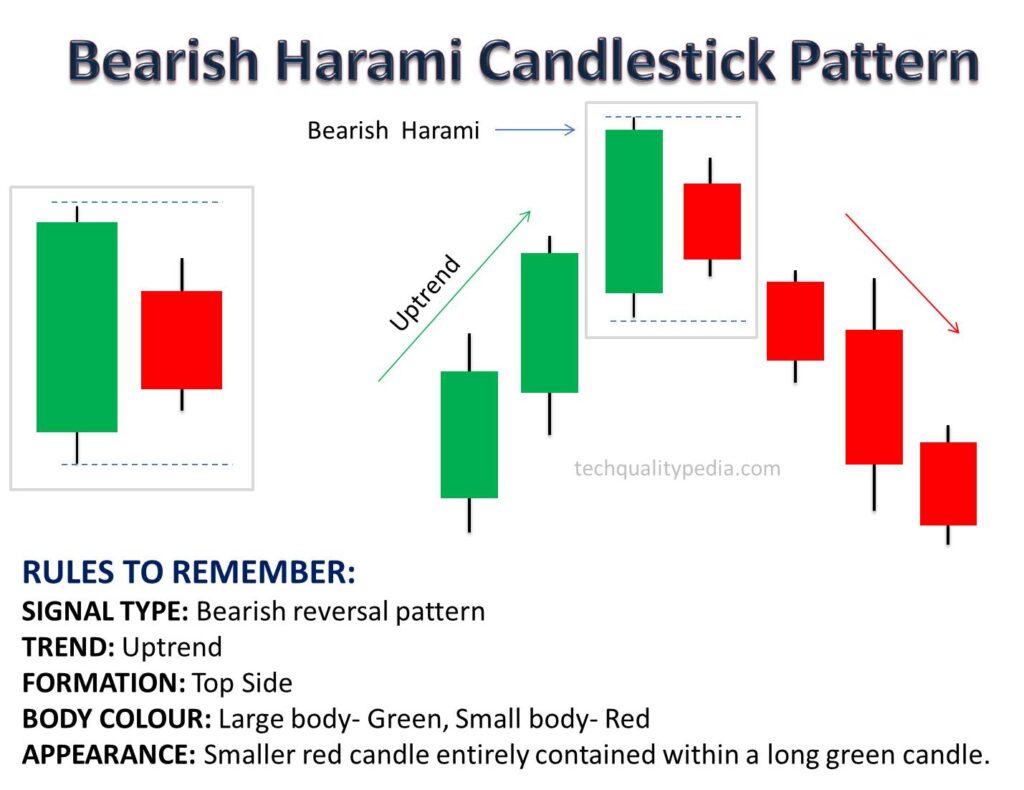
Explanation: The Bearish Harami candlestick appears after an uptrend and indicates a bearish reversal. The large green body candle shows strong buying pressure, but the smaller red body candle inside the long green candle indicates that buyers are losing control, and sellers are starting to take control, which could lead to a price decline.
Candlestick Patterns Evening Star
Image Description: Evening star candlestick patterns form with three candlesticks. The first one is a long candle with a green color body, followed by a small candle (it can be a green or red color body), and the third one is a long candle with a red body.
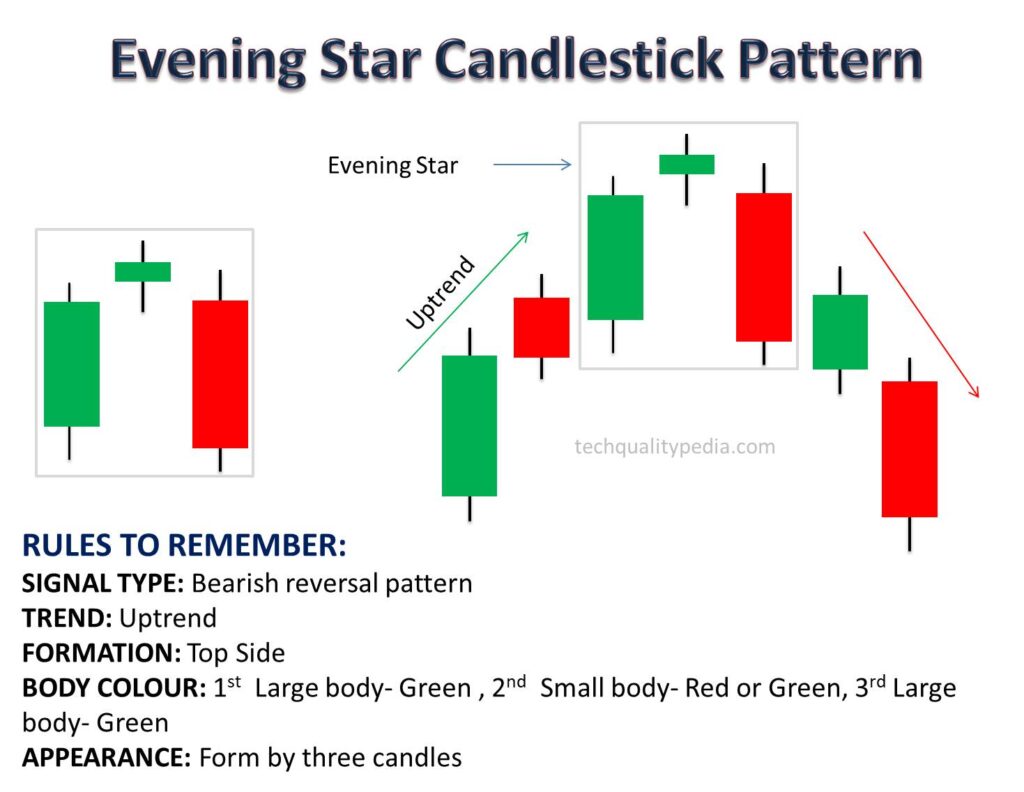
Explanation: Candlestick patterns morning star form a bearish reversal pattern after an uptrend. The small middle candle indicates indecision, and the third red candle confirms the strong bearish reversal.
CANDLESTICK PATTERNS NEUTRAL
There are two types of Neutral Candlestick Patterns formed:
- Doji Candlestick Pattern
- Spinning Top Candlestick Pattern
Candlestick Patterns Doji
Doji Candlestick Meaning
A “Doji” is a Japanese term that means “the same thing”. It indicates uncertainty and indecision in the stock market. When a doji pattern appears, traders use it as a signal to proceed cautiously and await further confirmation on making any buying or selling decisions.
Doji Candlestick Types
There are different types of doji candlestick patterns, including:
- Doji (Bullish or Bearish Reversal)
- Dragonfly Doji (Bullish Reversal)
- Gravestone Doji (Bearish Reversal)
Candlestick Patterns Doji | Doji Star Candle
A Doji candlestick is also known as a Classic Doji or Doji Star candle.
Image Description: Candlestick Doji forms neutral candlestick patterns with very small or no body. The upper and lower wick sizes are generally longer, but it can vary.
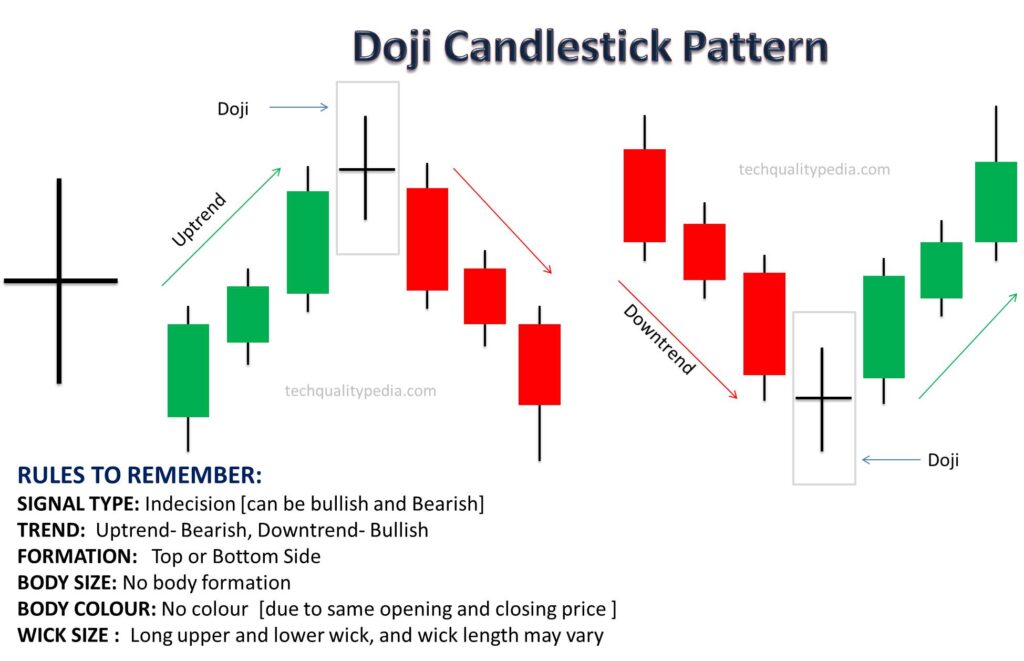
Explanation: A Doji candlestick with no or very small body indicating nearly the same open and close prices, represents uncertainty and indecision in the market. A Doji candlestick pattern may signal a reversal or a continuation of the trend.
Candlestick Patterns Spinning Top
Image Description: A candlestick with a small body with long upper and lower wicks.
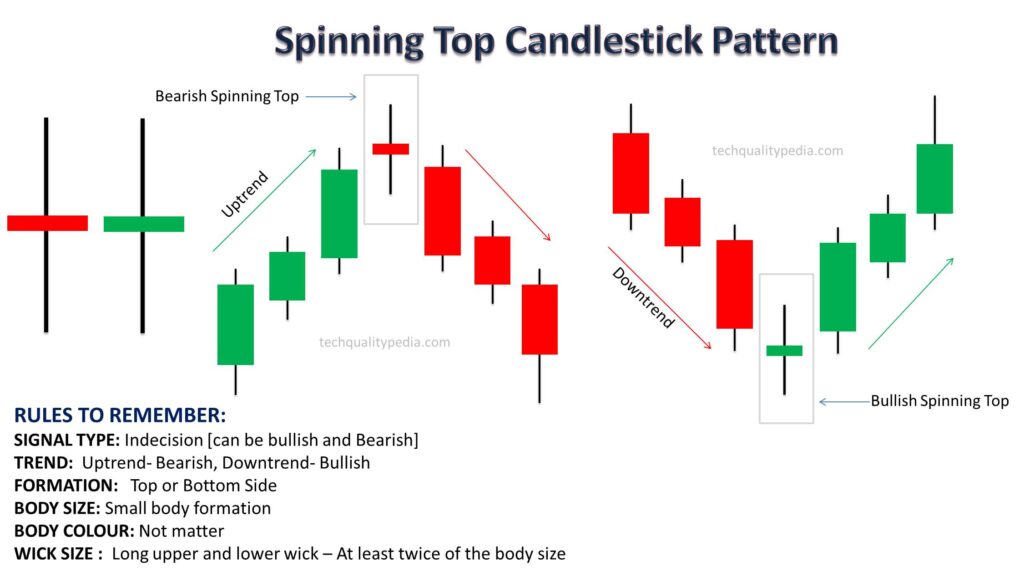
Explanation: A spinning Top candlestick also shows uncertainty and indecision in the market, where neither buyers nor sellers are in control. It may signal trend continuation or reversal.
CONCLUSION
Candlestick patterns provide valuable information about the market price movement and sentiments. Traders or investors can improve their ability to predict and respond to changes in the market by becoming proficient in these patterns. However, it’s important to approach trading and investment with a comprehensive strategy that makes use of risk management and multiple analytical/technical tools such as Indicators and Oscillators (e.g. RSI, Moving Average, MACD, etc.).

9hqy57
a7j3cl
d8x2u8
eta879
I got what you mean , regards for posting.Woh I am happy to find this website through google.
topfej
Hello my friend! I wish to say that this article is awesome, great written and come with almost all significant infos. I would like to look extra posts like this .
5opw8t
Amazing blog! Do you have any hints for aspiring writers? I’m hoping to start my own site soon but I’m a little lost on everything. Would you recommend starting with a free platform like WordPress or go for a paid option? There are so many choices out there that I’m completely overwhelmed .. Any recommendations? Kudos!
I like this website so much, saved to fav.
Magnificent beat ! I wish to apprentice even as you amend your website, how can i subscribe for a weblog site? The account aided me a applicable deal. I have been tiny bit familiar of this your broadcast offered brilliant transparent idea
I couldn’t resist commenting
With havin so much content do you ever run into any issues of plagorism or copyright infringement? My blog has a lot of completely unique content I’ve either written myself or outsourced but it seems a lot of it is popping it up all over the internet without my authorization. Do you know any ways to help protect against content from being stolen? I’d certainly appreciate it.
As a Newbie, I am continuously browsing online for articles that can aid me. Thank you
I have been absent for a while, but now I remember why I used to love this website. Thank you, I’ll try and check back more often. How frequently you update your website?
Hey, you used to write fantastic, but the last several posts have been kinda boring?K I miss your tremendous writings. Past few posts are just a little bit out of track! come on!
Heya i’m for the first time here. I came across this board and I find It truly helpful & it helped me out a lot. I hope to provide something back and aid others such as you aided me.
Very well written information. It will be valuable to anybody who employess it, including yours truly :). Keep doing what you are doing – i will definitely read more posts.
It¦s really a great and helpful piece of information. I am happy that you shared this useful info with us. Please keep us informed like this. Thanks for sharing.
Its good as your other content : D, thankyou for posting. “I catnap now and then, but I think while I nap, so it’s not a waste of time.” by Martha Stewart.
An attention-grabbing discussion is price comment. I feel that it is best to write more on this subject, it may not be a taboo topic however generally people are not enough to talk on such topics. To the next. Cheers
Thanks for every other informative website. The place else may just I get that kind of info written in such a perfect means? I have a undertaking that I’m simply now working on, and I’ve been at the glance out for such information.
I don’t unremarkably comment but I gotta state appreciate it for the post on this one : D.
Hi, i read your blog occasionally and i own a similar one and i was just curious if you get a lot of spam remarks? If so how do you reduce it, any plugin or anything you can suggest? I get so much lately it’s driving me mad so any assistance is very much appreciated.
Thanks for your personal marvelous posting! I seriously enjoyed reading it, you may be a great author.I will remember to bookmark your blog and definitely will come back later on. I want to encourage yourself to continue your great job, have a nice holiday weekend!
ljx9qa
Hello, Neat post. There is a problem along with your site in internet explorer, might check this?K IE nonetheless is the market leader and a good section of folks will pass over your magnificent writing due to this problem.
Some genuinely marvellous work on behalf of the owner of this site, perfectly great subject material.
I don’t even know how I ended up here, but I thought this post was great. I don’t know who you are but certainly you’re going to a famous blogger if you aren’t already 😉 Cheers!
Its like you read my mind! You appear to know a lot about this, such as you wrote the e-book in it or something. I believe that you simply could do with a few percent to force the message home a bit, however instead of that, that is magnificent blog. A fantastic read. I will certainly be back.
Hi there! Quick question that’s entirely off topic. Do you know how to make your site mobile friendly? My website looks weird when browsing from my apple iphone. I’m trying to find a template or plugin that might be able to correct this problem. If you have any suggestions, please share. Appreciate it!
Thanks, I have just been searching for information about this subject for a long time and yours is the greatest I’ve came upon till now. However, what concerning the conclusion? Are you sure in regards to the source?
I got what you intend, thanks for posting.Woh I am glad to find this website through google. “I was walking down the street wearing glasses when the prescription ran out.” by Steven Wright.
I’ve been browsing on-line greater than three hours lately, yet I by no means discovered any attention-grabbing article like yours. It?¦s pretty worth sufficient for me. In my view, if all website owners and bloggers made good content as you did, the net will likely be a lot more useful than ever before.
Today, I went to the beach front with my children. I found a sea shell and gave it to my 4 year old daughter and said “You can hear the ocean if you put this to your ear.” She placed the shell to her ear and screamed. There was a hermit crab inside and it pinched her ear. She never wants to go back! LoL I know this is entirely off topic but I had to tell someone!
Those are yours alright! . We at least need to get these people stealing images to start blogging! They probably just did a image search and grabbed them. They look good though!
Good web site! I truly love how it is simple on my eyes and the data are well written. I’m wondering how I could be notified when a new post has been made. I have subscribed to your RSS feed which must do the trick! Have a great day!
I truly enjoy reading on this site, it has got wonderful content.
My brother recommended I might like this web site. He was entirely right. This post actually made my day. You can not imagine simply how much time I had spent for this information! Thanks!
I truly appreciate this post. I have been looking all over for this! Thank goodness I found it on Bing. You have made my day! Thank you again!
I’m not sure where you are getting your information, but great topic. I needs to spend some time learning much more or understanding more. Thanks for fantastic information I was looking for this info for my mission.
I’m really enjoying the design and layout of your site. It’s a very easy on the eyes which makes it much more enjoyable for me to come here and visit more often. Did you hire out a developer to create your theme? Fantastic work!
Hello there, I discovered your site by way of Google whilst searching for a related topic, your site got here up, it looks great. I’ve bookmarked it in my google bookmarks.
Good day! Do you know if they make any plugins to help with Search Engine Optimization? I’m trying to get my blog to rank for some targeted keywords but I’m not seeing very good success. If you know of any please share. Thanks!
Hello! I just would like to give a huge thumbs up for the great info you have here on this post. I will be coming back to your blog for more soon.
I am extremely impressed with your writing skills as well as with the layout on your blog. Is this a paid theme or did you modify it yourself? Either way keep up the excellent quality writing, it’s rare to see a nice blog like this one today..
Good day very cool web site!! Guy .. Beautiful .. Wonderful .. I will bookmark your web site and take the feeds additionally…I am glad to find so many helpful information here in the submit, we’d like work out extra techniques on this regard, thanks for sharing. . . . . .
But wanna say that this is very beneficial, Thanks for taking your time to write this.
I really happy to find this internet site on bing, just what I was looking for : D as well saved to my bookmarks.
Very interesting information!Perfect just what I was searching for!
You are my inspiration , I possess few blogs and often run out from to post .
After all, what a great site and informative posts, I will upload inbound link – bookmark this web site? Regards, Reader.
I do love the manner in which you have framed this specific difficulty plus it does indeed give us some fodder for thought. Nonetheless, from just what I have seen, I only wish when other remarks pile on that people today stay on issue and in no way get started on a tirade associated with the news du jour. All the same, thank you for this exceptional point and though I can not go along with the idea in totality, I regard your perspective.
Hello There. I found your blog using msn. This is a really well written article. I’ll make sure to bookmark it and return to read more of your useful information. Thanks for the post. I’ll definitely comeback.
Really enjoyed this blog post, can you make it so I receive an update sent in an email whenever you publish a new update?
Useful information. Fortunate me I discovered your web site by chance, and I’m shocked why this coincidence did not happened earlier! I bookmarked it.
Glad to be one of several visitants on this awful web site : D.
I want to express my gratitude for your kind-heartedness in support of individuals who require guidance on this important idea. Your real commitment to getting the message around came to be astonishingly valuable and have permitted most people just like me to achieve their endeavors. Your personal informative tutorial entails a whole lot a person like me and even more to my peers. Thank you; from everyone of us.
I was suggested this website through my cousin. I’m no longer positive whether this submit is written through him as no one else realize such distinctive about my trouble. You are amazing! Thanks!
You could certainly see your skills within the paintings you write. The sector hopes for more passionate writers like you who aren’t afraid to mention how they believe. Always follow your heart.
Very interesting information!Perfect just what I was searching for!
Wow! This blog looks just like my old one! It’s on a entirely different topic but it has pretty much the same page layout and design. Excellent choice of colors!
I must show my gratitude for your kindness supporting visitors who must have help on this issue. Your very own dedication to getting the message all around appeared to be extremely important and have all the time permitted folks like me to attain their ambitions. This valuable tips and hints implies a great deal a person like me and extremely more to my mates. Best wishes; from each one of us.
This actually answered my drawback, thank you!
I really like your writing style, wonderful info , appreciate it for putting up : D.
The Salt Trick is a natural technique that involves using specific salts, such as Blue Salt, to enhance male performance
Enjoyed studying this, very good stuff, thankyou. “All things are difficult before they are easy.” by John Norley.
The Natural Mounjaro Recipe is more than just a diet—it’s a sustainable and natural approach to weight management and overall health.
wonderful submit, very informative. I wonder why the other experts of this sector do not notice this. You should continue your writing. I am confident, you’ve a huge readers’ base already!
Great wordpress blog here.. It’s hard to find quality writing like yours these days. I really appreciate people like you! take care
The Natural Mounjaro Recipe is more than just a diet—it’s a sustainable and natural approach to weight management and overall health.
I have not checked in here for a while since I thought it was getting boring, but the last several posts are great quality so I guess I will add you back to my everyday bloglist. You deserve it my friend 🙂
PrimeBiome is a dietary supplement designed to support gut health by promoting a balanced microbiome, enhancing digestion, and boosting overall well-being.
Very nice post. I just stumbled upon your weblog and wished to say that I have truly enjoyed browsing your blog posts. In any case I’ll be subscribing to your feed and I hope you write again soon!
Hi , I do believe this is an excellent blog. I stumbled upon it on Yahoo , i will come back once again. Money and freedom is the best way to change, may you be rich and help other people.
Excellent read, I just passed this onto a friend who was doing a little research on that. And he just bought me lunch since I found it for him smile Thus let me rephrase that: Thank you for lunch! “Whenever you have an efficient government you have a dictatorship.” by Harry S Truman.
Unquestionably believe that that you said. Your favourite justification seemed to be at the net the easiest factor to keep in mind of. I say to you, I certainly get annoyed whilst people think about concerns that they plainly do not know about. You managed to hit the nail upon the top and outlined out the entire thing with no need side-effects , other people could take a signal. Will likely be back to get more. Thank you
I like this web site so much, saved to my bookmarks. “Nostalgia isn’t what it used to be.” by Peter De Vries.
Pretty nice post. I just stumbled upon your blog and wanted to say that I’ve really enjoyed browsing your blog posts. In any case I’ll be subscribing in your feed and I’m hoping you write once more very soon!
Outstanding post, I think people should larn a lot from this weblog its rattling user friendly.
I have read a few excellent stuff here. Certainly price bookmarking for revisiting. I surprise how so much effort you put to make this sort of excellent informative site.
You have observed very interesting details ! ps decent site.
Hey there, I think your website might be having browser compatibility issues. When I look at your website in Opera, it looks fine but when opening in Internet Explorer, it has some overlapping. I just wanted to give you a quick heads up! Other then that, superb blog!
I appreciate, cause I found just what I was looking for. You have ended my four day long hunt! God Bless you man. Have a nice day. Bye
Hello! I know this is kind of off topic but I was wondering which blog platform are you using for this site? I’m getting tired of WordPress because I’ve had issues with hackers and I’m looking at options for another platform. I would be great if you could point me in the direction of a good platform.
Whoa! This blog looks exactly like my old one! It’s on a entirely different topic but it has pretty much the same layout and design. Superb choice of colors!
I don’t usually comment but I gotta state thankyou for the post on this perfect one : D.
Someone essentially help to make seriously posts I would state. This is the very first time I frequented your web page and thus far? I surprised with the research you made to create this particular publish amazing. Wonderful job!
Utterly written articles, regards for selective information. “No human thing is of serious importance.” by Plato.
Some genuinely excellent content on this internet site, thanks for contribution.
Just a smiling visitor here to share the love (:, btw outstanding design and style. “Individuals may form communities, but it is institutions alone that can create a nation.” by Benjamin Disraeli.
I’ve been exploring for a bit for any high-quality articles or blog posts on this sort of area . Exploring in Yahoo I at last stumbled upon this web site. Reading this information So i am happy to convey that I have an incredibly good uncanny feeling I discovered just what I needed. I most certainly will make certain to don’t forget this site and give it a look on a constant basis.
Have you ever thought about including a little bit more than just your articles? I mean, what you say is valuable and all. But think about if you added some great visuals or video clips to give your posts more, “pop”! Your content is excellent but with pics and videos, this blog could definitely be one of the most beneficial in its field. Great blog!
I am not positive where you are getting your information, however good topic. I must spend some time finding out much more or figuring out more. Thank you for excellent information I used to be looking for this info for my mission.
Right now it sounds like Expression Engine is the best blogging platform out there right now.
(from what I’ve read) Is that what you are using on your blog?
Compre visualizações e espectadores reais para suas lives no YouTube, Instagram, Twitch, TikTok e Facebook. Aumente seu engajamento e credibilidade online com serviços seguros e confiáveis. Impulsione suas transmissões ao vivo hoje!
Hi! Do you use Twitter? I’d like to follow you if that would be okay. I’m definitely enjoying your blog and look forward to new updates.
You are my intake, I have few blogs and often run out from to post : (.
I intended to put you the very little observation to be able to say thank you again just for the splendid techniques you’ve provided in this case. This has been so incredibly open-handed with you to convey easily all that numerous people could possibly have offered for sale for an ebook to end up making some bucks for themselves, notably given that you could have done it if you considered necessary. These principles additionally acted to provide a easy way to fully grasp the rest have a similar desire just like my very own to realize more and more when considering this condition. I’m sure there are several more pleasurable situations ahead for folks who check out your website.
I am not positive where you are getting your information, however good topic. I must spend some time learning more or working out more. Thanks for magnificent info I used to be in search of this information for my mission.
Choosing the Nursing Professionals Certificates online website is a wise decision for individuals seeking to advance their careers in the healthcare field. This platform offers a comprehensive range of courses designed by industry experts, covering topics such as patient care, disease prevention, and healthcare technology. The website provides an interactive and user-friendly learning experience, with resources including videos, quizzes, and discussion forums to enhance understanding and retention of key concepts. In addition, the site offers flexible scheduling options for busy professionals looking to further their education while working full-time. With its accreditation and recognition within the nursing community, choosing Nursing Professionals Certificates online ensures that learners receive quality education and relevant skills that can be immediately applied in clinical settings. By investing in this reputable platform, individuals can position themselves for success in today’s competitive healthcare landscape.
Real nice pattern and good content material, nothing else we want : D.
Good info. Lucky me I reach on your website by accident, I bookmarked it.
I and my guys appeared to be taking note of the best hints found on your web site then all of a sudden developed a horrible feeling I had not expressed respect to the website owner for those techniques. Those boys appeared to be totally very interested to learn them and have unquestionably been taking pleasure in these things. Many thanks for getting considerably thoughtful and then for utilizing these kinds of cool themes most people are really eager to learn about. My sincere apologies for not expressing appreciation to you sooner.
Can I just say what a relief to find someone who actually knows what theyre talking about on the internet. You definitely know how to bring an issue to light and make it important. More people need to read this and understand this side of the story. I cant believe youre not more popular because you definitely have the gift.
It?¦s actually a nice and helpful piece of info. I?¦m glad that you shared this useful info with us. Please keep us up to date like this. Thanks for sharing.
I’m extremely inspired together with your writing skills and also with the layout for your blog. Is this a paid topic or did you modify it your self? Anyway keep up the nice quality writing, it is rare to peer a nice blog like this one these days..
It is truly a great and helpful piece of information. I am glad that you shared this useful info with us. Please stay us informed like this. Thanks for sharing.
ynw0sd
Good day! I know this is kinda off topic however I’d figured I’d ask. Would you be interested in trading links or maybe guest authoring a blog article or vice-versa? My site addresses a lot of the same topics as yours and I feel we could greatly benefit from each other. If you are interested feel free to shoot me an e-mail. I look forward to hearing from you! Great blog by the way!
Valuable info. Lucky me I found your website by accident, and I am shocked why this accident didn’t happened earlier! I bookmarked it.
I’ll right away grab your rss feed as I can’t find your email subscription link or e-newsletter service. Do you have any? Please let me know in order that I could subscribe. Thanks.
The Salt Trick is a natural technique that involves using specific salts, such as Blue Salt, to enhance male performance
The Salt Trick is a natural technique that involves using specific salts, such as Blue Salt, to enhance male performance
This really answered my problem, thank you!
The Salt Trick is a natural technique that involves using specific salts, such as Blue Salt, to enhance male performance
Wow! This blog looks just like my old one! It’s on a entirely different topic but it has pretty much the same page layout and design. Superb choice of colors!
Hi, Neat post. There’s an issue along with your site in internet explorer, would test this?
IE nonetheless is the market chief and a big component of people will omit your excellent writing due
to this problem.
Its like you learn my mind! You seem to grasp a lot approximately this, like you wrote the book in it or something. I believe that you simply could do with a few to drive the message house a little bit, however instead of that, this is wonderful blog. An excellent read. I will certainly be back.
Hi! Do you know if they make any plugins to assist with SEO? I’m trying to get my blog to rank for some targeted keywords but I’m not seeing very good results. If you know of any please share. Thank you!
The Ice Water Hack has been gaining popularity as a simple method to aid weight loss. After reading about its potential benefits, I decided to give it a shot and see how it worked for me. Here’s what I found!
Howdy! I’m at work surfing around your blog from my new iphone 4! Just wanted to say I love reading through your blog and look forward to all your posts! Carry on the fantastic work!
Mitolyn is a cutting-edge natural dietary supplement designed to support effective weight loss and improve overall wellness.
I like this web blog very much, Its a really nice spot to read and find information.
F*ckin’ tremendous things here. I am very glad to see your article. Thanks a lot and i am having a look forward to contact you. Will you kindly drop me a mail?
As a Newbie, I am constantly exploring online for articles that can aid me. Thank you
Merely wanna comment on few general things, The website design and style is perfect, the subject material is rattling wonderful. “We can only learn to love by loving.” by Iris Murdoch.
Great – I should certainly pronounce, impressed with your web site. I had no trouble navigating through all the tabs as well as related info ended up being truly simple to do to access. I recently found what I hoped for before you know it at all. Reasonably unusual. Is likely to appreciate it for those who add forums or something, site theme . a tones way for your customer to communicate. Excellent task.
If you’ve been looking for a way to unlock your full mental potential and attract wealth effortlessly, Billionaire Brain Wave might just be the breakthrough you’ve been waiting for!
Some really nice stuff on this web site, I like it.
After research just a few of the blog posts on your web site now, and I really like your way of blogging. I bookmarked it to my bookmark website listing and can be checking back soon. Pls take a look at my website online as well and let me know what you think.
I’m impressed, I have to say. Really hardly ever do I encounter a blog that’s each educative and entertaining, and let me tell you, you might have hit the nail on the head. Your concept is outstanding; the problem is something that not enough individuals are talking intelligently about. I am very comfortable that I stumbled across this in my seek for one thing regarding this.
I just could not go away your web site prior to suggesting that I really enjoyed the usual info a person provide in your guests? Is gonna be back frequently to check out new posts.
My wife and i got now cheerful Louis could do his survey through the precious recommendations he acquired out of your blog. It’s not at all simplistic just to always be giving for free tips and tricks some people might have been making money from. So we see we need the writer to thank because of that. The entire explanations you made, the easy website menu, the friendships your site make it possible to create – it’s got everything unbelievable, and it’s leading our son in addition to the family do think the content is amusing, and that is wonderfully indispensable. Many thanks for everything!
I like this post, enjoyed this one thank you for posting. “The reward for conformity was that everyone liked you except yourself.” by Rita Mae Brown.
You are my aspiration, I own few blogs and sometimes run out from brand :). “The soul that is within me no man can degrade.” by Frederick Douglas.
You have remarked very interesting points! ps nice internet site.
I savor, cause I discovered just what I used to be looking for. You have ended my 4 day long hunt! God Bless you man. Have a nice day. Bye
Greetings from California! I’m bored to tears at work so I decided to browse your website on my iphone during lunch break. I enjoy the information you present here and can’t wait to take a look when I get home. I’m surprised at how fast your blog loaded on my mobile .. I’m not even using WIFI, just 3G .. Anyhow, good site!
I am glad to be one of the visitors on this great internet site (:, appreciate it for putting up.
Your style is so unique compared to many other people. Thank you for publishing when you have the opportunity,Guess I will just make this bookmarked.2
Amazing blog! Is your theme custom made or did you download it from somewhere? A design like yours with a few simple adjustements would really make my blog stand out. Please let me know where you got your design. Appreciate it
You made some decent points there. I did a search on the subject and found most people will agree with your blog.
I truly appreciate this post. I have been looking all over for this! Thank goodness I found it on Bing. You have made my day! Thank you again
you are really a excellent webmaster. The website loading velocity is amazing. It kind of feels that you are doing any distinctive trick. Also, The contents are masterpiece. you’ve performed a wonderful activity in this topic!
Very interesting points you have remarked, regards for putting up.
Hello! I could have sworn I’ve been to this blog before but after browsing through some of the post I realized it’s new to me. Anyways, I’m definitely happy I found it and I’ll be book-marking and checking back frequently!
You have observed very interesting details ! ps decent website .
I like what you guys are up too. Such smart work and reporting! Keep up the excellent works guys I’ve incorporated you guys to my blogroll. I think it’ll improve the value of my web site :).
I just could not leave your website before suggesting that I actually enjoyed the standard info an individual provide for your guests? Is gonna be back incessantly to inspect new posts.
Thanks for another informative blog. The place else may just I am getting that kind of info written in such an ideal way? I have a challenge that I’m simply now running on, and I have been on the glance out for such info.
Some genuinely nice stuff on this web site, I enjoy it.
I like this blog its a master peace ! Glad I discovered this on google .
I¦ve been exploring for a bit for any high quality articles or weblog posts on this sort of area . Exploring in Yahoo I ultimately stumbled upon this website. Reading this information So i¦m satisfied to exhibit that I’ve a very excellent uncanny feeling I found out exactly what I needed. I most certainly will make sure to do not overlook this website and provides it a glance on a continuing basis.
I don’t even know how I ended up here, but I thought this post was great. I don’t know who you are but certainly you are going to a famous blogger if you are not already 😉 Cheers!
Great remarkable things here. I am very satisfied to see your post. Thank you so much and i’m looking ahead to touch you. Will you kindly drop me a mail?
Hello would you mind letting me know which webhost you’re working with? I’ve loaded your blog in 3 different internet browsers and I must say this blog loads a lot quicker then most. Can you recommend a good hosting provider at a honest price? Thank you, I appreciate it!
I am glad to be a visitor of this staring web blog! , regards for this rare information! .
I truly appreciate this post. I’ve been looking everywhere for this! Thank goodness I found it on Bing. You’ve made my day! Thx again!
Its superb as your other blog posts : D, thankyou for putting up.
Thank you for some other wonderful post. The place else may just anyone get that kind of information in such an ideal approach of writing? I’ve a presentation next week, and I’m at the search for such info.
My brother suggested I may like this website. He used to be totally right. This post actually made my day. You can not imagine simply how much time I had spent for this info! Thank you!
It’s truly a nice and useful piece of information. I’m glad that you simply shared this helpful info with us. Please keep us up to date like this. Thanks for sharing.
Wow, superb blog format! How lengthy have you been running a blog for? you made running a blog glance easy. The entire glance of your site is excellent, as neatly as the content!
I got what you mean ,saved to my bookmarks, very decent website .
Very interesting details you have mentioned, regards for putting up. “Without courage, wisdom bears no fruit.” by Baltasar Gracian.
Very well written information. It will be helpful to everyone who usess it, as well as yours truly :). Keep doing what you are doing – i will definitely read more posts.
I truly appreciate this post. I have been looking all over for this! Thank goodness I found it on Bing. You have made my day! Thank you again
I think this is one of the most vital info for me. And i am glad reading your article. But should remark on few general things, The web site style is wonderful, the articles is really nice : D. Good job, cheers
Saved as a favorite, I really like your blog!
You actually make it seem really easy with your presentation but I to find this matter to be actually something which I think I would by no means understand. It kind of feels too complicated and very large for me. I’m having a look ahead to your next put up, I will try to get the hold of it!
Super-Duper blog! I am loving it!! Will come back again. I am bookmarking your feeds also.
Some really interesting points you have written.Helped me a lot, just what I was looking for : D.
Generally I don’t read article on blogs, but I wish to say that this write-up very forced me to take a look at and do it! Your writing taste has been surprised me. Thank you, very nice post.
Thank you for sharing with us, I conceive this website really stands out : D.
Greetings from Carolina! I’m bored at work so I decided to browse your blog on my iphone during lunch break. I enjoy the knowledge you provide here and can’t wait to take a look when I get home. I’m shocked at how fast your blog loaded on my mobile .. I’m not even using WIFI, just 3G .. Anyways, amazing site!
Good ?V I should definitely pronounce, impressed with your site. I had no trouble navigating through all the tabs and related info ended up being truly simple to do to access. I recently found what I hoped for before you know it at all. Reasonably unusual. Is likely to appreciate it for those who add forums or something, web site theme . a tones way for your customer to communicate. Nice task..
I have learn several just right stuff here. Definitely value bookmarking for revisiting. I wonder how so much attempt you place to create such a great informative web site.
I admire your piece of work, appreciate it for all the interesting posts.
excellent put up, very informative. I’m wondering why the opposite experts of this sector do not notice this. You should proceed your writing. I am sure, you’ve a great readers’ base already!
I went over this internet site and I conceive you have a lot of wonderful information, saved to my bookmarks (:.
Dead pent content, appreciate it for information. “The earth was made round so we would not see too far down the road.” by Karen Blixen.
I¦ll immediately grasp your rss as I can’t find your e-mail subscription hyperlink or e-newsletter service. Do you have any? Kindly let me understand so that I may just subscribe. Thanks.
We are a group of volunteers and opening a new scheme in our community. Your site offered us with valuable info to work on. You’ve done an impressive job and our entire community will be grateful to you.
I am glad to be one of several visitants on this great internet site (:, regards for posting.
I think this web site has got some real superb information for everyone : D.
I carry on listening to the rumor speak about getting boundless online grant applications so I have been looking around for the top site to get one. Could you advise me please, where could i acquire some?
Admiring the persistence you put into your blog and detailed information you present. It’s awesome to come across a blog every once in a while that isn’t the same old rehashed material. Great read! I’ve bookmarked your site and I’m including your RSS feeds to my Google account.
Nice blog here! Also your web site loads up fast! What host are you using? Can I get your affiliate link to your host? I wish my web site loaded up as fast as yours lol
You really make it appear really easy along with your presentation however I to find this topic to be really something that I think I might never understand. It kind of feels too complex and extremely large for me. I am taking a look forward on your next put up, I will attempt to get the hang of it!
There’s noticeably a bundle to know about this. I assume you made sure nice points in features also.
Hello, Neat post. There is a problem with your website in internet explorer, might check this… IE still is the market leader and a big element of folks will pass over your wonderful writing due to this problem.
Whats Taking place i am new to this, I stumbled upon this I’ve found It absolutely helpful and it has aided me out loads. I hope to give a contribution & help different users like its aided me. Great job.
Some genuinely nice and useful information on this website, also I conceive the pattern holds good features.
I was suggested this blog by way of my cousin. I’m now not positive whether this put up is written through him as no one else understand such certain approximately my trouble. You’re incredible! Thank you!
I am glad to be a visitant of this utter site! , thanks for this rare information! .
Good day! This is kind of off topic but I need some help from an established blog. Is it difficult to set up your own blog? I’m not very techincal but I can figure things out pretty fast. I’m thinking about making my own but I’m not sure where to begin. Do you have any points or suggestions? Thank you
I am now not positive where you’re getting your info, but great topic. I must spend a while finding out much more or understanding more. Thanks for wonderful information I used to be looking for this info for my mission.
Just wanna remark on few general things, The website design is perfect, the written content is real excellent. “I have seen the future and it doesn’t work.” by Robert Fulford.
Thank you for the auspicious writeup. It in fact was a amusement account it. Look advanced to far added agreeable from you! By the way, how can we communicate?
It’s really a great and helpful piece of information. I am glad that you shared this useful info with us. Please keep us informed like this. Thank you for sharing.
Well I really liked reading it. This information procured by you is very helpful for good planning.
Hi I am so glad I found your blog, I really found you by error, while I was researching on Aol for something else, Nonetheless I am here now and would just like to say cheers for a fantastic post and a all round entertaining blog (I also love the theme/design), I don’t have time to browse it all at the minute but I have saved it and also added your RSS feeds, so when I have time I will be back to read much more, Please do keep up the fantastic job.
I¦ll immediately take hold of your rss as I can not in finding your e-mail subscription hyperlink or newsletter service. Do you have any? Please allow me recognize so that I could subscribe. Thanks.
The Natural Mounjaro Recipe is more than just a diet—it’s a sustainable and natural approach to weight management and overall health.
Great post but I was wondering if you could write a litte more on this subject? I’d be very thankful if you could elaborate a little bit more. Appreciate it!
The Natural Mounjaro Recipe is more than just a diet—it’s a sustainable and natural approach to weight management and overall health.
Hey would you mind stating which blog platform you’re working with? I’m going to start my own blog in the near future but I’m having a tough time choosing between BlogEngine/Wordpress/B2evolution and Drupal. The reason I ask is because your design seems different then most blogs and I’m looking for something unique. P.S Sorry for being off-topic but I had to ask!
I got what you mean , thanks for putting up.Woh I am lucky to find this website through google. “Those who corrupt the public mind are just as evil as those who steal from the public.” by Theodor Wiesengrund Adorno.
A formidable share, I just given this onto a colleague who was doing a bit of analysis on this. And he the truth is purchased me breakfast as a result of I found it for him.. smile. So let me reword that: Thnx for the treat! However yeah Thnkx for spending the time to debate this, I feel strongly about it and love studying extra on this topic. If attainable, as you turn into expertise, would you thoughts updating your blog with extra details? It is extremely useful for me. Large thumb up for this blog post!
PrimeBiome is a dietary supplement designed to support gut health by promoting a balanced microbiome, enhancing digestion, and boosting overall well-being.
Hello. excellent job. I did not expect this. This is a fantastic story. Thanks!
PrimeBiome is a dietary supplement designed to support gut health by promoting a balanced microbiome, enhancing digestion, and boosting overall well-being.
You are a very capable person!
Hey There. I found your blog using msn. This is an extremely well written article. I’ll make sure to bookmark it and return to read more of your useful info. Thanks for the post. I’ll certainly comeback.
I like this website so much, saved to fav. “To hold a pen is to be at war.” by Francois Marie Arouet Voltaire.
The next time I read a blog, I hope that it doesnt disappoint me as much as this one. I mean, I know it was my choice to read, but I actually thought youd have something interesting to say. All I hear is a bunch of whining about something that you could fix if you werent too busy looking for attention.
Only wanna tell that this is very helpful, Thanks for taking your time to write this.
Awsome blog! I am loving it!! Will be back later to read some more. I am bookmarking your feeds also
I like what you guys are up too. Such smart work and reporting! Carry on the superb works guys I have incorporated you guys to my blogroll. I think it’ll improve the value of my website :).
I don’t usually comment but I gotta say thankyou for the post on this special one : D.
As a Newbie, I am continuously browsing online for articles that can be of assistance to me. Thank you
Heya i’m for the first time here. I came across this board and I find It truly useful & it helped me out much. I hope to give something back and help others like you helped me.
Merely wanna remark on few general things, The website pattern is perfect, the subject material is real superb. “All movements go too far.” by Bertrand Russell.
Woh I enjoy your articles, saved to favorites! .
I have learn several good stuff here. Certainly value bookmarking for revisiting. I surprise how a lot attempt you set to make such a fantastic informative web site.
I’m not that much of a online reader to be honest but your blogs really nice, keep it up! I’ll go ahead and bookmark your website to come back later. All the best
I cling on to listening to the newscast lecture about receiving boundless online grant applications so I have been looking around for the finest site to get one. Could you advise me please, where could i find some?
Hey, you used to write magnificent, but the last few posts have been kinda boringK I miss your super writings. Past several posts are just a little bit out of track! come on!
Really clean website , regards for this post.
I got what you mean , thanks for putting up.Woh I am thankful to find this website through google. “You must pray that the way be long, full of adventures and experiences.” by Constantine Peter Cavafy.
There is noticeably a bundle to learn about this. I assume you made certain good factors in options also.
Hello, Neat post. There is a problem with your website in web explorer, could test this… IE nonetheless is the marketplace chief and a large element of people will leave out your excellent writing due to this problem.
Some truly good content on this website, appreciate it for contribution. “An alcoholic is someone you don’t like who drinks as much as you do.” by Dylan Thomas.
Whats up very nice web site!! Man .. Beautiful .. Superb .. I’ll bookmark your web site and take the feeds alsoKI am satisfied to find so many useful info here within the post, we want work out more strategies in this regard, thank you for sharing. . . . . .
Definitely believe that which you said. Your favorite justification appeared to be on the internet the simplest thing to be aware of. I say to you, I definitely get irked while people think about worries that they plainly do not know about. You managed to hit the nail upon the top and defined out the whole thing without having side effect , people could take a signal. Will likely be back to get more. Thanks
Thanks for sharing excellent informations. Your website is so cool. I am impressed by the details that you have on this site. It reveals how nicely you perceive this subject. Bookmarked this website page, will come back for more articles. You, my friend, ROCK! I found just the information I already searched everywhere and simply couldn’t come across. What an ideal web site.
Excellent blog here! Also your site loads up fast! What web host are you using? Can I get your affiliate link to your host? I wish my website loaded up as fast as yours lol
Excellent blog here! Also your website quite a bit up fast! What web host are you using? Can I get your affiliate link on your host? I desire my website loaded up as quickly as yours lol
You made some first rate factors there. I seemed on the internet for the problem and located most people will go along with together with your website.
I will immediately grab your rss as I can not find your e-mail subscription link or e-newsletter service. Do you have any? Please let me know in order that I could subscribe. Thanks.
Hello my friend! I wish to say that this article is amazing, nice written and include approximately all important infos. I’d like to see more posts like this.
As a Newbie, I am always browsing online for articles that can help me. Thank you
This is a topic close to my heart cheers, where are your contact details though?
But wanna remark on few general things, The website style is perfect, the content is very great. “The enemy is anybody who’s going to get you killed, no matter which side he’s on.” by Joseph Heller.
Great post. I was checking constantly this weblog and I am impressed! Extremely useful info specifically the closing section 🙂 I maintain such info much. I used to be looking for this certain information for a long time. Thank you and best of luck.
Some truly good info , Gladiola I found this. “Use your imagination not to scare yourself to death but to inspire yourself to life.” by Adele Brookman.
You got a very good website, Glad I noticed it through yahoo.
This actually answered my problem, thank you!
Hey there! I could have sworn I’ve been to this site before but after browsing through some of the post I realized it’s new to me. Anyhow, I’m definitely glad I found it and I’ll be book-marking and checking back frequently!
hi!,I love your writing so much! percentage we communicate more approximately your post on AOL? I need an expert on this area to unravel my problem. May be that is you! Taking a look ahead to peer you.
As I web-site possessor I believe the content matter here is rattling wonderful , appreciate it for your hard work. You should keep it up forever! Good Luck.
Your place is valueble for me. Thanks!…
Greetings! Very helpful advice on this article! It is the little changes that make the biggest changes. Thanks a lot for sharing!
Thanks for sharing superb informations. Your site is very cool. I am impressed by the details that you have on this blog. It reveals how nicely you understand this subject. Bookmarked this website page, will come back for more articles. You, my pal, ROCK! I found simply the info I already searched all over the place and just couldn’t come across. What an ideal web-site.
Well I sincerely liked studying it. This information offered by you is very practical for accurate planning.
Pretty! This was a really wonderful post. Thank you for your provided information.
Very interesting topic, regards for putting up.
I cling on to listening to the reports speak about receiving free online grant applications so I have been looking around for the best site to get one. Could you advise me please, where could i acquire some?
You made some first rate points there. I looked on the web for the difficulty and found most individuals will go together with with your website.
You have mentioned very interesting details ! ps nice site.
I’m curious to find out what blog system you have been utilizing? I’m experiencing some minor security problems with my latest site and I’d like to find something more safe. Do you have any solutions?
I?¦ve recently started a website, the information you offer on this web site has helped me greatly. Thanks for all of your time & work.
What’s Happening i’m new to this, I stumbled upon this I have found It absolutely helpful and it has aided me out loads. I hope to give a contribution & help different customers like its aided me. Great job.
I believe this web site has got some real wonderful info for everyone :D. “As ill-luck would have it.” by Miguel de Cervantes.
At this time it looks like Movable Type is the best blogging platform out there right now. (from what I’ve read) Is that what you are using on your blog?
Hi there! Do you know if they make any plugins to protect against hackers? I’m kinda paranoid about losing everything I’ve worked hard on. Any recommendations?
You are my breathing in, I own few blogs and infrequently run out from post :). “Follow your inclinations with due regard to the policeman round the corner.” by W. Somerset Maugham.
Hey just wanted to give you a brief heads up and let you know a few of the images aren’t loading correctly. I’m not sure why but I think its a linking issue. I’ve tried it in two different browsers and both show the same results.
Thanks a lot for sharing this with all of us you actually know what you are talking about! Bookmarked. Kindly also visit my website =). We could have a link exchange agreement between us!
Once I originally commented I clicked the -Notify me when new feedback are added- checkbox and now each time a comment is added I get 4 emails with the identical comment. Is there any method you’ll be able to take away me from that service? Thanks!
Crypto payment gateway for your business. Boost your sales, cut costs, and streamline your operations by accepting cryptocurrency payments. Experience secure, fast transactions and unlock global business opportunities